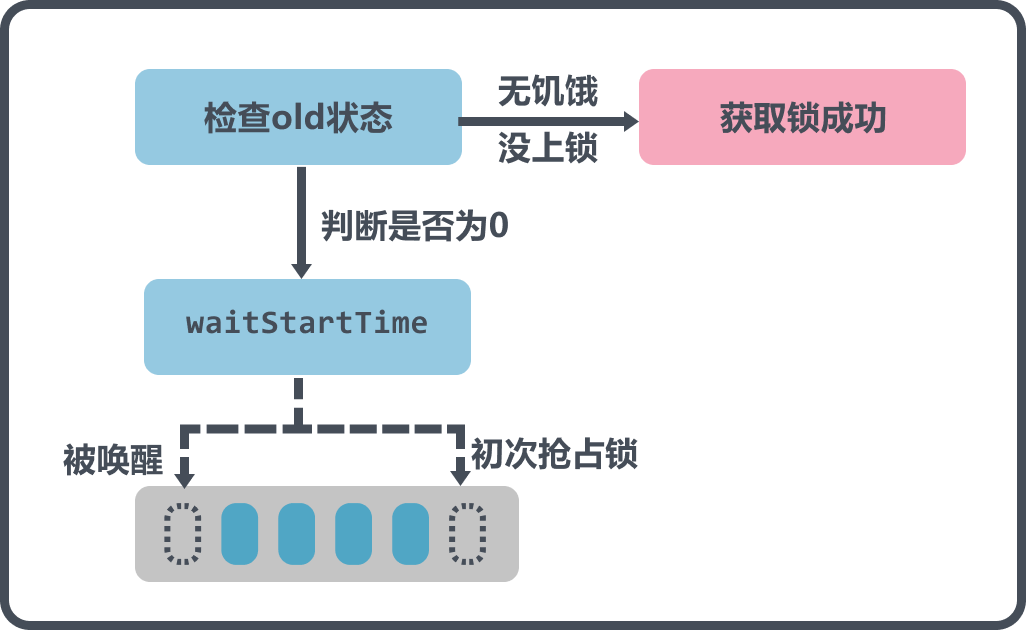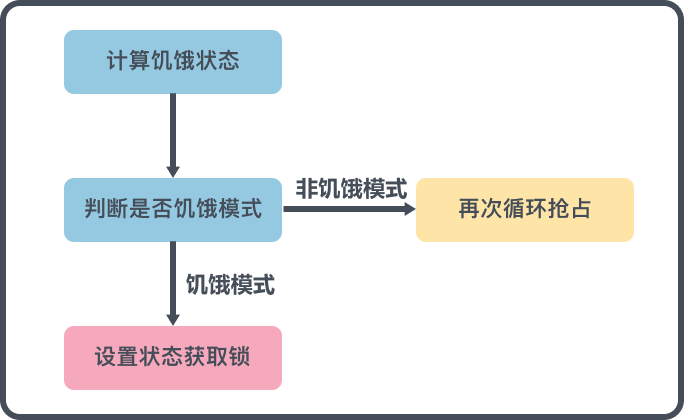主要常量和结构 #
type Mutex struct {
state int32 // 表示当前互斥锁的状态
sema uint32 // 用于控制锁状态的信号量
}const (
mutexLocked = 1 << iota // mutex is locked
mutexWoken
mutexStarving
mutexWaiterShift = iota
starvationThresholdNs = 1e6
)mutexLocked、mutexWoken、mutextStarving 是 Mutex 的状态位,分别表示锁是否已被持有、锁是否唤醒、锁的操作模式(正常模式、饥饿模式),mutexWaiterShift 表示等待者数量
对于 starvationThresholdNs 常量源码中有详细描述:
Mutex fairness.
互斥锁有两种操作模式:正常模式和饥饿模式。
- 在正常模式中,等待者会被放入先进先出的等待队列,但是一个刚被唤醒的等待者并不会持有锁,而是会和刚到达的协程竞争锁,后者更有优势,因为新到达的协程正在 CPU 上执行并且可能数量可能会很多。因此刚被唤醒的协程有很大的可能获得锁失败,此时该等待者会被放回等待队列头部,如果等待者获得锁时间超过 1ms,就会将互斥锁的操作模式切换成饥饿模式
- 在饥饿模式中,锁的所有权会从释放锁的协程直接移交给等待队列的第一个等待者,新到达的协程即使在无协程获得锁时也不会尝试获得锁,也不会自旋,取而代之的是直接将自己置于等待队列尾部。如果一个等待者在以下两种情况下获得锁,将从饥饿模式切换回正常模式:
- 该等待者是等待队列的最后一个等待者
- 该等待者等待锁的时间小于 1ms
正常模式的性能更好,因为即使有阻塞的等待者,一个协程也会去连续多次获取锁。饥饿模式对于避免尾部延迟是很重要。
初次看到可能会比较困惑,接下来基于源码对以上互斥锁结构和两种操作模式做更详细的描述。
主要方法 #
func (m *Mutex) Lock()func (m *Mutex) Unlock()func (m *Mutex) lockSlow()func (m *Mutex) unlockSlow(new int32)
Lock #
// Lock locks m.
// If the lock is already in use, the calling goroutine
// blocks until the mutex is available.
func (m *Mutex) Lock() {
// Fast path: grab unlocked mutex.
if atomic.CompareAndSwapInt32(&m.state, 0, mutexLocked) {
... // 竞态检测相关代码
return
}
// Slow path (outlined so that the fast path can be inlined)
m.lockSlow()
}go 提供导出的加锁注释部分说明了该方法功能:加锁,如果锁已被持有,会将协程阻塞至锁可获得。方法内容很精炼:
- 使用原子包的 CAS 函数尝试修改 mutex 的状态位,如果锁未被持有则锁住锁,如果成功锁住,直接返回
- 如果 CAS 获得锁失败,就调用
lockSlow去加锁
lockSlow #
自旋 #
lockSlow[1] 方法主要是由一个 for 循环构成。依次拆分分析:
var waitStartTime int64
starving := false
awoke := false
iter := 0
old := m.state首先定义了等待开始时间 waitStartTime,然后将 awoken、starving 设置成 false,将 m.state 的状态保存在 old 变量中
for {
// Don't spin in starvation mode, ownership is handed off to waiters
// so we won't be able to acquire the mutex anyway.
if old&(mutexLocked|mutexStarving) == mutexLocked && runtime_canSpin(iter) {
...
}
...
}进入循环后首先是一个判断,old&(mutexLocked|mutexStarving) 表示取出 mutex 的锁位和操作模式位并判断是不是正常模式下锁被持有:
| 操作模式位 | 锁位 | 结果 |
|---|---|---|
| 正常模式 | 可用 | 0x0 |
| 正常模式 | 已被持有 | 01 |
| 饥饿模式 | 可用 | 10 |
| 饥饿模式 | 已被持有 | 11 |
const (
active_spin = 4
)
func sync_runtime_canSpin(i int) bool {
if i >= active_spin || ncpu <= 1 || gomaxprocs <= sched.npidle.Load()+sched.nmspinning.Load()+1 {
return false
}
if p := getg().m.p.ptr(); !runqempty(p) {
return false
}
return true
}判断的第二个部分调用了 runtime_canSpin,该函数注释中表明了作用(<Badge title="更详细" type="tip></Badge):
Active spinning for sync.Mutex.
sync.Mutex 是合作性的,因此对旋转持保守态度。仅旋转几次,并且仅当在多核计算机上运行并且 GOMAXPROCS 大于 1 并且至少有一个其他运行 P 并且当前 p 的本地 runq 为空时。与运行时互斥体相反,我们在这里不进行被动旋转,因为可以在全局 runq 或其他 P 上进行工作。
通过以上注释可以了解,当单核或多核但空闲 p 不足的情况,自旋无意义,无法获得 CPU,而当前 p 的本地队列非空的情况,与其自旋不如执行 runq 中等待的协程更高效。所以 runtime_canSpin 作用是判断当前 Goroutine 能否进入自旋。因此第一个判断语句可以执行的条件是:协程可自旋且处于正常模式。
// Active spinning makes sense.
// Try to set mutexWoken flag to inform Unlock to not wake other blocked goroutines.
if !awoke && old&mutexWoken == 0 && old>>mutexWaiterShift != 0 &&
atomic.CompareAndSwapInt32(&m.state, old, old|mutexWoken) {
awoke = true
}
runtime_doSpin()
iter++
old = m.state
continue满足条件会执行以上逻辑:
old&mutexWoken == 0判断 mutex 的唤醒位是否为 0,old>>mutexWaiterShift != 0将 mutex 状态位右移三位,即当前等待获取锁的协程数量非 0。满足条件后使用 CAS 将 mutex 的唤醒位置 1,通知UnLock不要唤醒其他阻塞的协程()- 结束了第一个判断后会调用
runtime_doSpin进行自旋,并更新 mutex 的状态位
自旋结束后,锁通过自旋获得了 mutexWoken 状态;其它协程获得了 mutexWoken 状态,当前协程自旋无效,awoke 仍位 false
重新计算锁状态 #
new := old
// Don't try to acquire starving mutex, new arriving goroutines must queue.
if old&mutexStarving == 0 {
new |= mutexLocked
}
if old&(mutexLocked|mutexStarving) != 0 {
new += 1 << mutexWaiterShift
}
// The current goroutine switches mutex to starvation mode.
// But if the mutex is currently unlocked, don't do the switch.
// Unlock expects that starving mutex has waiters, which will not
// be true in this case.
if starving && old&mutexLocked != 0 {
new |= mutexStarving
}
if awoke {
// The goroutine has been woken from sleep,
// so we need to reset the flag in either case.
if new&mutexWoken == 0 {
throw("sync: inconsistent mutex state")
}
new &^= mutexWoken
}进过自旋之后,会重新计算锁状态,用 new 表示如果获得锁成功后需要更新的状态
- 正常模式下加锁,则锁位应该置 1:
new |= mutexLocked - 如果处于饥饿模式或者锁已被其他协程持有,则将等待者数量增加 1
- 如果处于饥饿状态,并且已经上锁了,那么
mutexStarving状态位设置为 1。这里判断上锁的情况是因为处于饥饿模式时????,锁不会解开,会直接传递给等待队列的第一个协程,所以 ??? - 如果在自旋时修改
mutexWoken成功,则将new的mutexWoken位取消,因为后续的以下情况都不属于已唤醒状态了,而如果UnLock的时候发现mutexWoken的位置非 0,就不会去唤醒,则该线程就无法再醒来加锁- 获得锁成功
- 获得锁失败,被挂起阻塞,等待唤醒
继续加锁/阻塞 #
if atomic.CompareAndSwapInt32(&m.state, old, new) {
} else {
old = m.state
}
计算完新的状态后执行 CAS 更新锁,如果更新失败了,则获取锁最新的状态重新执行 for 循环
if old&(mutexLocked|mutexStarving) == 0 {
break // locked the mutex with CAS
}
CAS 更新成功之后会验证锁之前是否是未锁定/正常模式状态,如果是的话说明 CAS 函数已经成功使当前协程持有锁了
// If we were already waiting before, queue at the front of the queue.
queueLifo := waitStartTime != 0
if waitStartTime == 0 {
waitStartTime = runtime_nanotime()
}
runtime_SemacquireMutex(&m.sema, queueLifo, 1)//go:linkname sync_runtime_SemacquireMutex sync.runtime_SemacquireMutex
func sync_runtime_SemacquireMutex(addr *uint32, lifo bool, skipframes int) {
semacquire1(addr, lifo, semaBlockProfile|semaMutexProfile, skipframes, waitReasonSyncMutexLock)
}逻辑继续往下走说明要么锁处于饥饿模式,要么是锁从一开始到现在一直是锁的,则调用 runtime_SemacquireMutex 将协程放入等待队列,唤醒后仍未获得锁的协程将放入等待队列头部,首次进入等待队列时则放入等待队列尾部,并设置起始时间,阻塞等待。runtime_SemacquireMutex 在运行时最终会调用 semacquire1[2] 函数,后文后详细描述,主要作用是让当前协程阻塞???queueLifo??
唤醒 #
runtime_SemacquireMutex(&m.sema, queueLifo, 1)
starving = starving || runtime_nanotime()-waitStartTime > starvationThresholdNs
old = m.state
当某个协程释放锁,当前协程被唤醒,会更新 mutex 的饥饿状态,已经是饥饿状态或者等待了 starvationThresholdNs 即 1ms 都会标记是饥饿状态并获取锁的最新状态。
if old&mutexStarving != 0 {
delta := int32(mutexLocked - 1<<mutexWaiterShift)
if !starving || old>>mutexWaiterShift == 1 {
delta -= mutexStarving
}
atomic.AddInt32(&m.state, delta)
break
}
awoke = true
iter = 0- 判断当前锁是否为饥饿模式:
- 如果为饥饿模式但最新计算的饥饿状态为正常状态或是当前 mutex 仅剩 1 个等待着,则将 mutex 的
mutexStarving位置 0 - 获得锁成功,退出整个 for 循环(因为饥饿模式并不会更新锁的
mutexLocked,只会在解锁的时候传递给下一位,所以在下一位获取锁的位置只需要判断是否仍处于饥饿状态,不处于饥饿状态时清空mutexLocked)
- 如果为饥饿模式但最新计算的饥饿状态为正常状态或是当前 mutex 仅剩 1 个等待着,则将 mutex 的
- 设置
awoke为 true,清空自旋次数,重新开始通过 for 循环从自旋这一步开始获取锁
UnLock #
func (m *Mutex) Unlock() {
new := atomic.AddInt32(&m.state, -mutexLocked)
if new != 0 {
m.unlockSlow(new)
}
}互斥锁的解锁会先使用 sync/atomic.AddInt32 函数快速解锁:
- 如果该函数返回的新状态等于 0,当前 goroutine 就成功解锁了互斥锁;
- 如果该函数返回的新状态不等于 0,会调用
unlockSlow开始慢速解锁:
unlockSlow #
func (m *Mutex) unlockSlow(new int32) {
if new&mutexStarving == 0 {
old := new
for {
if old>>mutexWaiterShift == 0 || old&(mutexLocked|mutexWoken|mutexStarving) != 0 {
return
}
// Grab the right to wake someone.
new = (old - 1<<mutexWaiterShift) | mutexWoken
if atomic.CompareAndSwapInt32(&m.state, old, new) {
runtime_Semrelease(&m.sema, false, 1)
return
}
old = m.state
}
} else {
// Starving mode: handoff mutex ownership to the next waiter, and yield
// our time slice so that the next waiter can start to run immediately.
// Note: mutexLocked is not set, the waiter will set it after wakeup.
// But mutex is still considered locked if mutexStarving is set,
// so new coming goroutines won't acquire it.
runtime_Semrelease(&m.sema, true, 1)
}
}- 在正常模式下(
new&mutexStarving == 0)会进入一个循环:- 如果互斥锁不存在等待者或者互斥锁的 mutexLocked、mutexStarving、mutexWoken 状态不都为 0(说明已经有协程在处理 mutex),那么当前方法可以直接返回,不需要唤醒其他等待者;
- 如果互斥锁存在等待者,会通过
runtime_Semrelease[3] 唤醒等待者并移交锁的所有权;
- 在饥饿模式下,上述代码会直接调用
runtime_Semrelease将当前锁交给下一个正在尝试获取锁的等待者,等待者被唤醒后会得到锁,在这时互斥锁还不会退出饥饿状态;
小结 #
加锁:
- 如果互斥锁处于初始化状态,会通过置位 mutexLocked 加锁;
- 如果互斥锁处于 mutexLocked 状态并且在普通模式下工作,会进入自旋,执行 30 次 PAUSE 指令消耗 CPU 时间等待锁的释放;
- 如果当前 Goroutine 等待锁的时间超过了 1ms,互斥锁就会切换到饥饿模式;
- 互斥锁在正常情况下会通过 runtime.sync_runtime_SemacquireMutex 将尝试获取锁的 Goroutine 切换至休眠状态,等待锁的持有者唤醒;
- 如果当前 Goroutine 是互斥锁上的最后一个等待的协程或者等待的时间小于 1ms,那么它会将互斥锁切换回正常模式;
解锁:
- 当互斥锁已经被解锁时,调用 sync.Mutex.Unlock 会直接抛出异常;
- 当互斥锁处于饥饿模式时,将锁的所有权交给队列中的下一个等待者,等待者会负责设置 mutexLocked 标志位;
- 当互斥锁处于普通模式时,如果没有 Goroutine 等待锁的释放或者已经有被唤醒的 Goroutine 获得了锁,会直接返回;在其他情况下会通过 sync.runtime_Semrelease 唤醒对应的 Goroutine;
Reference #
Codes #
- ↩︎
func (m *Mutex) lockSlow() { var waitStartTime int64 starving := false awoke := false iter := 0 old := m.state for { // Don't spin in starvation mode, ownership is handed off to waiters // so we won't be able to acquire the mutex anyway. if old&(mutexLocked|mutexStarving) == mutexLocked && runtime_canSpin(iter) { // Active spinning makes sense. // Try to set mutexWoken flag to inform Unlock // to not wake other blocked goroutines. if !awoke && old&mutexWoken == 0 && old>>mutexWaiterShift != 0 && atomic.CompareAndSwapInt32(&m.state, old, old|mutexWoken) { awoke = true } runtime_doSpin() iter++ old = m.state continue } new := old // Don't try to acquire starving mutex, new arriving goroutines must queue. if old&mutexStarving == 0 { new |= mutexLocked } if old&(mutexLocked|mutexStarving) != 0 { new += 1 << mutexWaiterShift } // The current goroutine switches mutex to starvation mode. // But if the mutex is currently unlocked, don't do the switch. // Unlock expects that starving mutex has waiters, which will not // be true in this case. if starving && old&mutexLocked != 0 { new |= mutexStarving } if awoke { // The goroutine has been woken from sleep, // so we need to reset the flag in either case. if new&mutexWoken == 0 { throw("sync: inconsistent mutex state") } new &^= mutexWoken } if atomic.CompareAndSwapInt32(&m.state, old, new) { if old&(mutexLocked|mutexStarving) == 0 { break // locked the mutex with CAS } // If we were already waiting before, queue at the front of the queue. queueLifo := waitStartTime != 0 if waitStartTime == 0 { waitStartTime = runtime_nanotime() } runtime_SemacquireMutex(&m.sema, queueLifo, 1) starving = starving || runtime_nanotime()-waitStartTime > starvationThresholdNs old = m.state if old&mutexStarving != 0 { // If this goroutine was woken and mutex is in starvation mode, // ownership was handed off to us but mutex is in somewhat // inconsistent state: mutexLocked is not set and we are still // accounted as waiter. Fix that. if old&(mutexLocked|mutexWoken) != 0 || old>>mutexWaiterShift == 0 { throw("sync: inconsistent mutex state") } delta := int32(mutexLocked - 1<<mutexWaiterShift) if !starving || old>>mutexWaiterShift == 1 { // Exit starvation mode. // Critical to do it here and consider wait time. // Starvation mode is so inefficient, that two goroutines // can go lock-step infinitely once they switch mutex // to starvation mode. delta -= mutexStarving } atomic.AddInt32(&m.state, delta) break } awoke = true iter = 0 } else { old = m.state } } if race.Enabled { race.Acquire(unsafe.Pointer(m)) } } - ↩︎
func semacquire1(addr *uint32, lifo bool, profile semaProfileFlags, skipframes int, reason waitReason) { gp := getg() if gp != gp.m.curg { throw("semacquire not on the G stack") } // Easy case. if cansemacquire(addr) { return } // Harder case: // increment waiter count // try cansemacquire one more time, return if succeeded // enqueue itself as a waiter // sleep // (waiter descriptor is dequeued by signaler) s := acquireSudog() root := semtable.rootFor(addr) t0 := int64(0) s.releasetime = 0 s.acquiretime = 0 s.ticket = 0 if profile&semaBlockProfile != 0 && blockprofilerate > 0 { t0 = cputicks() s.releasetime = -1 } if profile&semaMutexProfile != 0 && mutexprofilerate > 0 { if t0 == 0 { t0 = cputicks() } s.acquiretime = t0 } for { lockWithRank(&root.lock, lockRankRoot) // Add ourselves to nwait to disable "easy case" in semrelease. root.nwait.Add(1) // Check cansemacquire to avoid missed wakeup. if cansemacquire(addr) { root.nwait.Add(-1) unlock(&root.lock) break } // Any semrelease after the cansemacquire knows we're waiting // (we set nwait above), so go to sleep. root.queue(addr, s, lifo) goparkunlock(&root.lock, reason, traceBlockSync, 4+skipframes) if s.ticket != 0 || cansemacquire(addr) { break } } if s.releasetime > 0 { blockevent(s.releasetime-t0, 3+skipframes) } releaseSudog(s) } - ↩︎
// Semrelease atomically increments *s and notifies a waiting goroutine // if one is blocked in Semacquire. // It is intended as a simple wakeup primitive for use by the synchronization // library and should not be used directly. // If handoff is true, pass count directly to the first waiter. // skipframes is the number of frames to omit during tracing, counting from // runtime_Semrelease's caller. func runtime_Semrelease(s *uint32, handoff bool, skipframes int)






